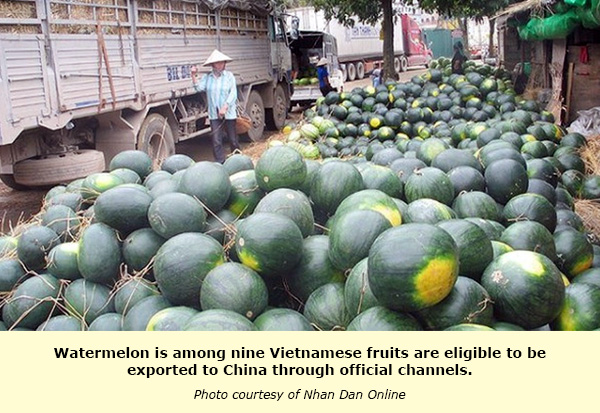Vietnam’s exports of fruit and vegetables reached more than US$3.7 billion in 2019, down 1.9% compared to 2018, which was mainly due to the sharp decline in export quantity and revenue regarding the Chinese market, according to the Ministry of Agriculture and Rural Development.
Although China remained the leading export market of Vietnamese fruit and vegetables in 2019, Vietnam’s export turnover to this market in the first 11 months of 2019 fell by 13.2% over the same period in 2018. The decline came from China’s tightening of imports through unofficial channels, causing big changes for a number of Vietnam’s agricultural exports, including fruit and vegetables.

In addition, many producers and Vietnamese enterprises are still confused by the standards and regulations that China has set for eligiblity to export to China through official channels. Specifically, the regulations relate to the traceability and planting area registration of agricultural products, and the registration of packaging manufacturers and labels of products, among others.
In particular, a number of fruits exported to China must meet specific regulations, including that the transport of watermelons must use porous mesh and that jackfruit is wrapped in kraft paper or contained in carton boxes with printed traceability information. Bananas must be put into paper boxes or plastic bags with codes of origin printed with traceability information. So far, only nine Vietnamese fruits are eligible to be exported to China through official channels, namely dragon fruit, watermelon, rambutan, mango, lychee, longan, banana, jackfruit and mangosteen.
In the context of declining exports to the Chinese market, Vietnamese fruit and vegetables saw increasing export value to fastidious markets in 2019.
Notably, Vietnam’s fruit and vegetable exports to the US reached US$137.7 million in the first 11 months of 2019 (accounting for 4% of Vietnam’s total fruit and vegetable exports), up 9.2% over the same period in 2018. Meanwhile, Vietnam’s fruit and vegetable exports to the Republic of Korea were reported at US$119.4 million (accounting for 3.5%), up 14.2%; to Japan at US$112.4 million (accounting for 3.3%), up 14.4%; and to the Netherlands at US$73.8 million (accounting for 2.2%), up 34.8% compared to the same period in 2018.
There are six Vietnamese fruits exported officially to the US, including lychee, dragon fruit, mango, star apple, rambutan and longan. Vietnam has also successfully brought four types of fruit into the Australian market, namely lychee, mango, dragon fruit and longan.
We can see that our country’s fruit and vegetable exports are progressing in a new and sustainable direction. However, the quantity of fruit and vegetables exported to fastidious markets currently accounts for a very small proportion.
The fruit and vegetable sector still has much to do in order to fulfill the target export revenue of over US$4 million in 2020. First of all, Vietnam should fully implement the requirements from China to promote the official export of Vietnamese agricultural products to this market. Farmers, processing enterprises and exporters need to raise their awareness of Chinese requirements to make the necessary changes in production and business with great importance attached to the quality and traceability of products.
This is also an opportunity to boost the sustainable development and export of our country’s fruit and vegetable sector. In addition, Vietnam should develop specific strategies to quickly increase market shares in the fastidious markets of the US and Europe. Once accepted, Vietnamese fruit and vegetables will have an additional “passport” of quality, creating favorable conditions to occupy other markets in the world.
Source: Nhan Dan Online
